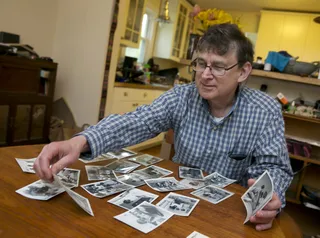'Freedom Summer' Changed the South 50 Years Ago
A look back at the turning point in the civil rights era.

1 / 12
Freedom Summer - It was the summer of 1964 and hundreds of volunteers gathered in Mississippi to call national attention to segregation in the south. They registered Black voters and established “Freedom Schools” that educated African-Americans about social and political change. Take a look at an overview of the historic turning point in the civil rights movement known as "Freedom Summer." — Natelege Whaley (@Natelege_) (Photo: AP Photo/Michael Clurman)

2 / 12
Planning for Change - In March 1964, the Student Nonviolent Coordinating Committee began planning the "Mississippi Summer Project." The organization sent mostly white Notherners into harm's way, as previous demonstrations had become bloody but brought little progress. (File: AP Photo/SNCC Legacy Project)

3 / 12
Gambling for Life - In this photo, Black and white students enter their training course to aid in Black voter registration at the campus of Western College for Women at Oxford, Ohio. The young people knew bringing change to the rising tensions in Mississippi would be a gamble for their lives. (Photo: AP Photo/Gene Smith, File)

4 / 12
Some Were Murdered - Days before preparation began, three volunteers, Andrew Goodman, James Chaney and Michael Schwerner, disappeared and were found buried near Philadelphia, Mississippi, on June 21, 1964. The men were investigating the burning of a Black church. The group was beaten and shot to death. This heightened the alarm felt by volunteers-in-training.(Photo: AP Photo/FBI, File)

5 / 12
Lasting Friendships - "Everybody told us our lives would be in danger," Aviva Futorian told the Associated Press. The 76-year-old attorney, who attended a Freedom School, befriended Roy DeBerry during the summer of 1964. "I probably didn't have as much trepidation as I should have. Because it's hard to imagine your own death." (Photo: AP Photo/M. Spencer Green)
ADVERTISEMENT

6 / 12
Justice Was in DeBerry's DNA - Nicknamed "Shorty," DeBerry joined the movement in Holly Springs, Mississippi, at the age of 16. He said he had an "independent streak" that motivated him to fight for justice. "No one needed to teach you that," the 66-year-old DeBerry told AP. "It was just something that was in your DNA." DeBerry met Futorian at a Freedom School, where she was teaching. (Photo: AP Photo/Michael Clurman)

7 / 12
"The Freedom House" - A photo of "The Freedom House," obtained from Larry Rubin, from The Associated Press. The home was headquarters to the Council of Federated Organizations, including the Student Nonviolent Coordinating Committee (SNCC), the NAACP and other groups that converged during Freedom Summer. (Photo: AP Photo/SNCC Legacy Project, Larry Rubin)

8 / 12
Voting Registration Only Signed on Few Voters - In this photo, a woman looks on at a display window of Black and white dolls at Capitol Street in Jackson, Mississippi. Only one-tenth of the 17,000 Black residents who tried to register to vote during the "Freedom Summer" succeeded. Yet, this activism still led to the creation of the Voting Rights Act of 1965. (Photo: AP Photo/Jim Bourdier, File)

9 / 12
Freedom Summer Created Lifelong Activists - After volunteering, DeBerry later graduated from high school and attended Futorian's alma mater, Brandeis University in Massachusetts. There, he started the Black Student Union and pushed for a Black studies department. (Photo: AP Photo/Allen G. Breed)

10 / 12
Michael Clurman Looks Back on Historic Summer - Michael Clurman was a former volunteer at "Freedom Schools." He joined with DeBerry and knocked on doors to encourage people to register to vote. Clurman looks over photos from the historic summer. (Photo: AP Photo/Richard Drew)
Photo By Photo: AP Photo/Richard Drew
ADVERTISEMENT

11 / 12
Futorian Went On to Be a Civil Rights Lawyer - After Futorian spent a year and a half volunteering in Mississippi, she returned to Chicago to become a civil rights lawyer after feeling her skin color would limit her. "I thought maybe I could be some kind of catalyst, and lawyers seemed to be good catalysts," she said. Throughout her career, she has focused on death row inmates and capital punishment in Illinois. (Photo: AP Photo/M. Spencer Green)
